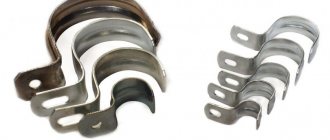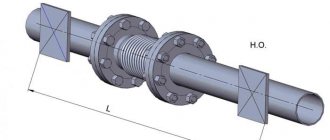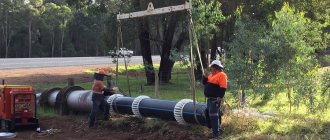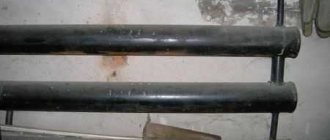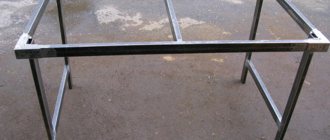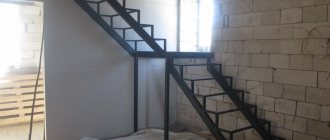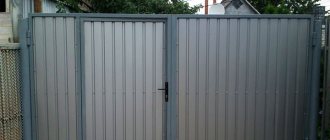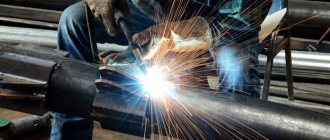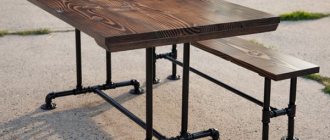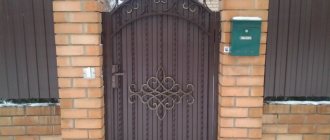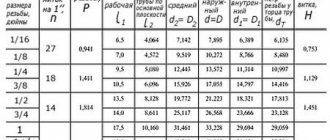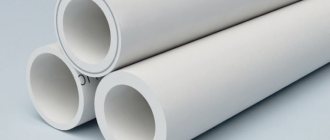Production of pipeline supports
Support products are made of steel. When operating a pipeline under normal conditions, standard long products are used. If the highway operates in specific conditions, then metal supports are selected that can withstand the load of high-temperature substances or exposure to a cold environment, for example, in the Far North.
The production of pipeline support structures includes the following stages:
- Cutting steel sheets on high precision machines.
- Cutting the material on a guillotine.
- Cutting steel sheets using belt equipment.
- Welding of elements.
Clamps are used to connect steel sections. They are produced on automated presses. Thanks to them, it is possible to achieve high quality elements. Metal supports are used for maintenance:
- oil pipelines;
- gas pipelines;
- for the operation of nuclear and thermal power plants;
- for launching polyurethane foam heating pipes.
The industry produces metal supports of the following types:
- Movable (sliding, roller, etc.).
- Fixed (clamp, welded, persistent).
Fixed supports for polyurethane foam heating pipes
Fixed products for polyurethane foam heating pipes are manufactured to install reliable fastening of the pipeline and maintain it in a given position.
Support for heating main
Such pipe supports are used in overhead and underground pipelines. The fixed structure is designed to compensate for the load of the external environment, for example, temperature fluctuations, vibration, pulsation, etc.
A fixed support for the polyurethane foam heating pipe is installed in combination with compensators, which help to evenly distribute the load. This is especially necessary for metal structures laid in the northern regions.
For fastening, the fixed structure uses clamps or welding. In order to firmly secure the clamps, stop strips are attached to the pipe by welding.
Fixed structures are widely used in the operation of polyurethane foam heating pipes. They are an important component of utility networks in polyurethane foam insulation. Supports for polyurethane foam heat supply pipes are operated in accordance with GOST 30732-2006.
Fixed structures for polyurethane foam heat supply can be used for underground installation of duct or non-duct type.
PPU heat supply structures are characterized by waterproofing, resistance to temperature fluctuations and corrosion. Although supports for polyurethane foam heating pipes are made of steel components, they do not require additional electrochemical protection.
Design
Fixed supports are metal structures in the form of a steel pipe located on a steel sheet designed to take the main load of the steel pipe, necessary to protect the polyethylene and galvanized shell, which serves as thermal insulation, from physical damage.
Fixed elements securely hold the pipeline, preventing shifts and movements that occur under the pressure of the moving fluid. Along the entire length of the pipeline, the supports distribute both horizontal and vertical loads, thereby protecting the pipe structure.
Fixed supports provide comprehensive protection of the pipeline.
Today, these supports are recommended to be installed in systems the main element of which is a steel pipe. Such systems include:
- Hot and cold water supply;
- Gas supply;
- Heating;
- Heat supply.
Thanks to the supports, the pipeline is segmented. The distance between the fixed supports depends on the properties of the expansion joints, which must take on the main load that appears when the pipeline increases under the influence of low temperatures. This is especially true for pipeline laying in northern regions, where temperature differences can cause the system to fail ahead of time.
Movable supports for fastening pipelines
Movable or sliding structures are used for fastening pipelines from 50 to 1620 mm. They take on vertical loads, which include the weight of the pipeline, the transported environment, atmospheric loads in the form of wind and precipitation.
Sliding steel supports for pipelines allow horizontal movement of the pipeline along its axis, which can occur due to thermal expansion of the steel walls of the pipeline.
The movable structure consists of:
- rigid base in the form of a channel;
- semicircular holder in the form of a clamp;
- clamp fastening;
- paronite gaskets;
- rollers.
Movable structures require a distance between them, taking into account the strength of the working surface of the highway. The distance between the supports can even vary depending on the diameter of the pipe.
Movable or sliding structures are divided into:
- Clamp fastenings with brackets.
- Suspended dielectric supports.
- Movable skating rink structures.
- Sliding ball bearings for lateral movement of the line.
Clamp movable structures are produced for fastening overhead technological lines with various transported substances.
Clamp sliding bearings demonstrate the following advantages:
- long service life;
- ease of fastening;
- strength.
Sliding structures keep the pipeline from moving vertically but allow horizontal movement.
Calculation of pipeline fastenings
Calculation of pipeline supports consists of identifying the distance between them based on data on the strength and deflection of the pipeline, as well as the installation method and pipe parameters.
To calculate the values between movable structures, use the table “Design of Heat Networks” by A.A. Nikolaev.
For example, the table shows the following calculation for horizontal placement: with a minimum pipe diameter of 20 mm and a maximum working environment temperature of 60˚C, the distance between the supports will be 60 cm. The larger the pipe diameter, the larger the step between them.
For vertical placement, the calculation of the fastening pitch is carried out according to the same principle. For example, with a pipeline diameter of 40 mm and a temperature of 20 degrees, the pipe support will be placed at a distance of 138 cm, and at a temperature of 70 degrees - 113 cm.
What are the benefits of sliding supports for pipelines?
Sliding models are necessary if communications pass along the surface of the earth. This ensures free movement of the pipeline in horizontal and vertical planes. Also, such devices protect the entire structure from premature abrasion.
It is impossible to do without sliding elements when installing systems that experience loads during seasonal temperature changes, because at this time the pipes expand and contract in two planes at once.
Thanks to sliding models, it is possible to achieve stability of communications and balance their movement in space that occurs when temperatures change.
The sliding model includes the following components:
- the base, the role of which is often played by a corner;
- semicircular metal pipe holder;
- pad;
- fasteners, that is, nuts and bolts.
Movable models are available in three types:
- hard;
- elastic;
- constant force designs.
Rigid models, in turn, are:
- guides;
- rigid suspensions;
- sliding supports.
The former do not allow communication to move downwards and horizontally. Suspensions of the second type allow you to achieve the greatest mobility of the entire structure. While the latter type eliminates the pipe moving down in the vertical direction. Elastic supports can boast such rigidity only if the pipe moves vertically. Then the following pattern works: the higher the load on the supporting element, the further the pipe moves. Note that the constant force support copes with any load, regardless of the displacement of the communication.
To protect this element of the system from rust, it is primed in several layers. Or it can be coated with primer enamel. But the highest degree of corrosion protection is provided by powder coating or galvanizing.
Typically, durable carbon steel is chosen as the material for the manufacture of such products. But it has to be replaced with low-alloy grades when it becomes known that the pipeline will be operated under conditions of large temperature fluctuations.
When classifying sliding supports for pipelines, it is not the price that is taken into account, but their design, therefore the following types are distinguished:
- on brackets (fastening elements);
- clamp;
- ball;
- dielectric;
- roller (roller).
Due to the rollers used in it, the roller design reduces the friction force between its base and the upper part. Note that friction is generated when the pipeline moves.
Dielectric sliding elements are chosen for pipes in the manufacture of which the following are used:
- carbon steel;
- low carbon steel.
Such structures require insulation from a special material - sheet paronite, which includes:
- rubber;
- asbestos;
- additional powder additives.
For the manufacture of ball sliding elements, steel is used, and they are considered a specific fastener. The fact is that with their help the pipe can move in two directions at once: longitudinal and transverse. Therefore, such models are most often installed at power plants and heating mains.
Typically, sliding type devices are isolated from metal casings using waterproofing. And the inner surface of the pipe and the waterproofing material are lubricated with a special graphite lubricant, which prevents friction. Next, weld the clamps and tighten them securely. It is important that when installing such structures you can do without special equipment, due to which the whole work takes much less time.
Purpose of fixed pipeline supports
During operation, pipes and other pipeline parts, shut-off, control, protective and other types of fittings experience various types of mechanical loads:
- soil movements and subsidence;
- vibrations from operating equipment and seismic activity;
- wind and snow loads;
- internal stresses in structural materials, welds and threaded connections;
- hydraulic shocks of the working environment;
- linear, annular and volumetric expansion of alloys and metals.
Foundations are most often constructed of concrete, and the transmission link between them and the pipeline itself is precisely the supports, which, on the one hand, follow the shape of the pipes, and on the other, provide a flat surface for installation on the foundation.
For rigid fixation of pipes/fittings to the foundations, fixed steel pipeline supports are used.
Go to the catalog of pipeline supports, production from 1st day.
Purpose of pipeline supports
It is possible to achieve tightness and operational safety of the system only if two parameters are observed at once: the selection of high-quality pipes and the use of additional equipment, that is, supports for process pipelines.
According to the documentation, we are not talking about a separate construction part, but about a structural element of communication.
Let’s immediately name the useful functions of this component of the pipeline:
- Protection of the pipe from damage at the point of contact with the structure.
- Ensuring the pipes are positioned correctly.
- Load distribution along the entire length of the structure and its transfer to the ground.
- Elimination of vibrations, reduction of voltage in the system.
We recommend articles on metalworking
- Steel grades: classification and interpretation
- Aluminum grades and areas of their application
- Defects in metal products: causes and search methods
The popular name “suspensions” has been assigned to supports for fixing pipes, but this term is not suitable for every type of fastening.
The fact is that all supporting structures existing today are divided into types based on:
- immobility/mobility;
- installation method.
If we talk about the installation method, then similar products can be:
- hanging;
- ordinary.
Suspended models are attached to ceilings, slabs and other means. They are considered movable supports for the pipeline, that is, they can move in two directions: across or along the axis of the structure. Whereas the stationary ones have a different task - they rigidly secure the pipe in a certain position.
Why are movable models needed?
- They reduce the stress coefficient in the system walls.
- The support reaction force of the pipeline is transmitted to the supporting structure, without changing the position of the point at which the transmission occurs.
Classification of fixed supports
Within their subcategory, fixed pipeline supports with rigid fixation of pipes are classified according to a number of characteristics:
structural material - concrete, reinforced concrete, steel assortment of brands, channel, I-beam, angle, tubular coils and sheet steel in the form of plates;
type of execution – welded or dismountable design with bolts/studs
support design - clamp, welded, yoke, bracket-shaped, with stops, panel, side, in polyurethane foam;
manufacturing standard - NTS 65-06, STO 79814898, OST 36-17, GOST 16127, GOST 14911, OST 108.275, OST 24.125, OST 34.10, OST 36-146.
There are frameless supports. Initially, the bulk of fixed supports for gas pipelines in Moscow are used from the 4.903-10, 5-903-13 and 1-487-1997.00.00 series. Or the structures are made according to drawings L8-136, L8-141 – 148, L8-180, L8-190 – 199, L8-200, L8-508 – 524.
Types of fixed supports
| Support name | Image | Dy, mm | Pressure |
| Fixed support for vertical pipelines VP OST 36-146-88 | 57-1420 | up to 10 MPa | |
| Fixed tubular support for steeply curved bends TO OST 36-146-88 | 57-630 | up to 10 MPa | |
| Fixed pipe support TR OST 36-146-88 | 57-630 | up to 10 MPa | |
| Fixed clamp frameless support KhB OST 36-146-88 | 25-530 | up to 10 MPa | |
| Fixed front double-support support T4 Series 4.903-10: Issue 4 | 108-1420 | up to 6.5 MPa | |
| Fixed frontal four-point support T5 Series 4.903-10: Issue 4 | 133-1420 | up to 6.5 MPa | |
| Fixed frontal double-support reinforced support T6 Series 4.903-10: Issue 4 | 108-1420 | up to 6.5 MPa | |
| Fixed front support four-point reinforced T7 Series 4.903-10: Issue 4 | 426-1420 | up to 6.5 MPa | |
| Fixed clamp frameless support T11 Series 4.903-10: Issue 4 | 108-1020 | up to 6.5 MPa | |
| Fixed clamp support T12 Series 4.903-10: Issue 4 | 57-377 | up to 6.5 MPa | |
| Fixed yoke support T44 Series 4.903-10: Issue 4 | 377-1420 | up to 6.5 MPa |
Types of fixed pipeline supports
Overpasses are made of pipes of different diameters, have branches, fittings and special equipment, pass underground, on the surface of the ground and at some elevation from it. Therefore, fixed pipeline supports have many design options, in which different technical solutions are used to support pipes and fix them in space without a single degree of freedom.
Supports in polyurethane foam insulation
Fixed pipeline supports in polyurethane foam insulation are used for channelless installation. The design has the form of a steel sleeve with external insulation in a galvanized shell inside a panel support made of thick-walled metal sheet. The support is mounted at the site of operation, and the main pipes are welded to the glass inside this standard product.
There are climatic versions HL and U with different thicknesses of the heat-insulating layer. For underground routes, a polyethylene shell is usually used, which is not destroyed by ground and soil waters. Ground and overhead highways are often built on fixed supports with a galvanized shell. The production of products is regulated by the GOST 30732 standard. The marking first indicates the parameters of the pipe, then the steel shield, the type of insulation and shell, and the standard number.
"Dead" support
On the one hand, a dead support has zero maintainability. On the other hand, the design is adjusted once and cannot loosen over time. Technically, a dead support usually looks like this:
- a piece of I-beam or channel located across the pipeline;
- pillows made of sheet material for pipes;
- clamp for welding to the pipe body.
Typically, dead supports become anchors in front of bending sections of pipelines and strengthen the main lines in the area where the branches adjoin. They are part of the series of fixed supports 4.903-10, certified according to the OST 36-17-85 standard.
Fixed supports of heating mains (6 photos)
Details Section: Heat Supply Category: Heating Networks Created 02/09/2015 17:43 Fixed supports are an element of any pipeline that gives the pipe system integrity and stability. Fixed supports are intended to receive and smooth out forces appearing in pipelines due to temperature fluctuations.
Fixed supports are designed to fix the pipeline and prevent it from moving in any direction under the weight of the transported medium. Fixed supports are used in almost all pipeline systems, the load-bearing basis of which is a steel pipe. These are pipelines for heat supply, heating, hot water supply and others.
Fixed supports come in two types: for overhead pipeline systems (a galvanized shell is used as waterproofing), or for underground non-channel pipelines (a polyethylene shell is used as waterproofing).
The main materials used when installing a fixed support: steel pipe, hot-rolled steel sheet, centralizer, polyurethane foam, polyethylene sheath, galvanized sheath, thermal tape.
The fixed support of the pipeline itself is a device made of a steel pipe that carries the main load to hold the steel flange (steel sheet with a thickness of 25 to 80 or more mm) from transverse or longitudinal shift of the pipeline, cups made of steel pipe that protect the polyethylene sheath and galvanized sheath from mechanical damage when installing a fixed support on a heating main, as well as thermal insulation made of polyurethane foam. To protect the structure from moisture, heat shrink tape is used.
The fixed support of the pipeline is secured with reinforced concrete frames during the installation process. Thus, the pipeline is fixed at certain points and divided into separate sections. The length of these sections of the heating main is determined by the compensating feature of the expansion joints (including bellows expansion joints) installed between the two nearest fixed supports to absorb the temperature expansion of the pipeline in insulation.
Fixed supports serve to absorb the forces that arise in pipelines as a result of temperature changes.
Random materials:
- Steel pipes in polyurethane foam insulation (6 photos) - 01/21/2015 13:00 - Read 3732 times
- Signal tape "Heating network" LST: purpose, examples of use - 04/27/2015 13:13 - Read 7666 times
- Types of heating networks (6 photos) - 02/16/2015 19:13 - Read 12641 times
- The border of the balance sheet ownership of heating networks (7 photos) - 02/25/2015 18:49 - Read 19242 times
- System UEC PPU pipelines (5 photos) - 02/04/2015 12:58 - Read 3715 times
- < Back
- Forward >
Buy fixed supports
Thanks to our own production, fixed pipeline supports have a low cost and selling price, respectively. Our service has a number of advantages:
- own design bureau;
- Availability of standard products in stock;
- The production time for a special order is on average 5 – 10 days;
- deferred payment up to 60 days;
- delivery throughout the Russian Federation by a transport company and our trucks;
- production of supports strictly according to GOST, TU, OST, ST standards and customer drawings.
In addition to supports, we sell the entire range of pipeline parts, control, shut-off and other fittings from leading Russian brands.
Pipe supports are essential for the installation of above-ground and above-ground systems. The pipes are connected to each other, resulting in a structure with a large length. However, the connections may become less reliable, and the system itself will lose strength if the structure is not firmly secured. The reliability of the system is influenced by many factors: climate, external vibrations, dead weight of structures and much more. Supports help reduce the negative impact of all these factors. They are used in the following industries:
- Gas and oil transportation systems;
- Systems of technological significance;
- Thermal and nuclear power plants;
- Engineering structures.
Standard diameters of supports for pipelines, according to GOST, are 18-1620 mm.
Peculiarities
Pipe supports are usually made of metal. Their installation is quite complicated. It is better if the installation is carried out by a professional. If installed incorrectly, not the most pleasant consequences are possible due to the fact that these parts are subject to a very large load both from the structures themselves and from the liquids that circulate in the system.
Installation can be carried out using a variety of technologies: using clamps, using welding equipment. The type of metal for structures is selected depending on its characteristics. The main thing is that it can withstand high loads. The distance between the supports is calculated depending on the diameter of the pipes, the type of transported substance, and the technology for installing the structure.
Varieties
Pipeline supports are divided into two main types: fixed and movable. The choice of a specific product depends on the operating conditions and operation of the system.
Fixed supports for pipelines are used to organize above-ground and above-ground systems. Special compensators are placed between these parts. They are necessary to reduce negative external influences: unstable temperature conditions, changes in internal pressure, various types of vibration. In addition, the parts perform the functions of a heat insulator. Most often, fixed structures can be found in the northern parts of Russia, which are characterized by sharp temperature fluctuations. You can see what these pipe supports look like in the photo.
Movable or sliding supports for pipes are distinguished by the fact that they take on vertical loads. The design does not affect pipeline wear. When pipes move, which is typical due to temperature changes, such products do not increase their stability. Movable structures are divided into sliding, clamp, ball spring and many others. The first two types are necessary for systems that can be deformed under the influence of temperature changes.
Spring products are needed to protect the system from vibrations. Ball structures are used when turning pipelines, as they provide free movement. Hanging products are necessary for fastening horizontal structures. You can see what these or other products look like in the photo.
In addition, supports for pipelines are classified depending on the design features and installation technology:
- Hull welded structures. Advantages: affordable cost, easy installation. Used for steel structures. They differ in a variety of design features. They can be both mobile and immobile;
- Housing clamp structures. They can be both mobile and immobile. They are divided into products with a round type clamp and a flat type clamp. The latter are used only for steel structures. Products with a round clamp can be used not only for steel, but also for pre-insulated structures. In addition, this type includes yoke structures, characterized by the presence of stiffeners;
- Frameless structures. We can say that these are ordinary clamps. They are divided into movable and immobile. The latter are connected to the base by welding, while the second type of products ensures free movement of the structure. Otherwise, frameless moving products are called clamp guides;
- Designs of steeply curved bends. This product is mounted under the bend of the structure. They can be movable or immobile. They are also used as structures for fastening various equipment;
- Panel structures. Necessary for securing vertical sections. Installed by welding. Often installed when the structure passes through the wall. They belong to the type of stationary types of products.
You can see all types of pipe supports in the photo. There are many sizes of these structures. The choice of products depends on the type of pipeline, its diameter, operating characteristics and other conditions.
Features of pipeline structures
The required tightness indicators and operational safety of various communications can be ensured not only through high-quality pipes, but also through the use of auxiliary equipment. This type of equipment includes supports for fastening.
If you look at the necessary documentation, you can find information that the support is not a separate construction part, but is regulated as a structural element of the communication itself. They have many useful features:
- At the point of contact with the support structure, it protects the pipe from damage.
- Ensures the correct location of the pipeline in space.
- Distributes the load along the entire length of the communication and transfers it to the supporting structures.
- Eliminates vibration disturbances and reduces voltage in the pipeline.
Supports for attaching pipes are also popularly called “hangers,” but such a term cannot be used in every situation. A suspension is a type of support structure. All supporting structures are divided into types depending on the following parameters:
- Immobility or mobility.
- Installation option.
According to the installation option, they are also divided into the following types:
- Hanging products.
- Regular.
You can fix suspended products to ceilings, slabs and other structures. Hanging models are of the movable type according to the installation option. The mobility of a support is a property that allows it to move across or along the axis of the pipeline. The movable supports can move in the two directions that have just been indicated. But the stationary ones firmly fix the material in the desired position.
Movable models perform the following functions:
- The stress coefficient in the pipeline walls is reduced.
- The support reaction force of the pipeline is transmitted to the supporting structure. It should also be noted that this process occurs without changing the position of the point at which the transmission of the support reaction occurs.
